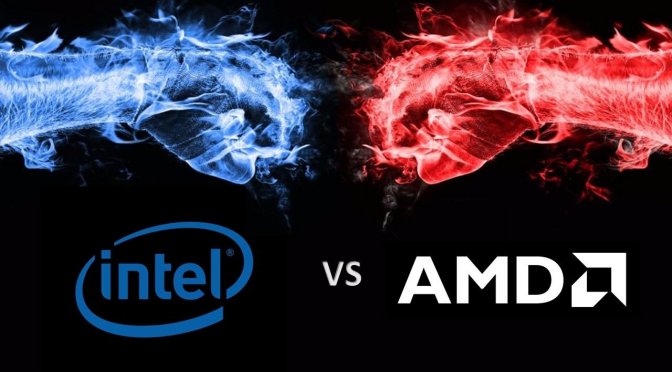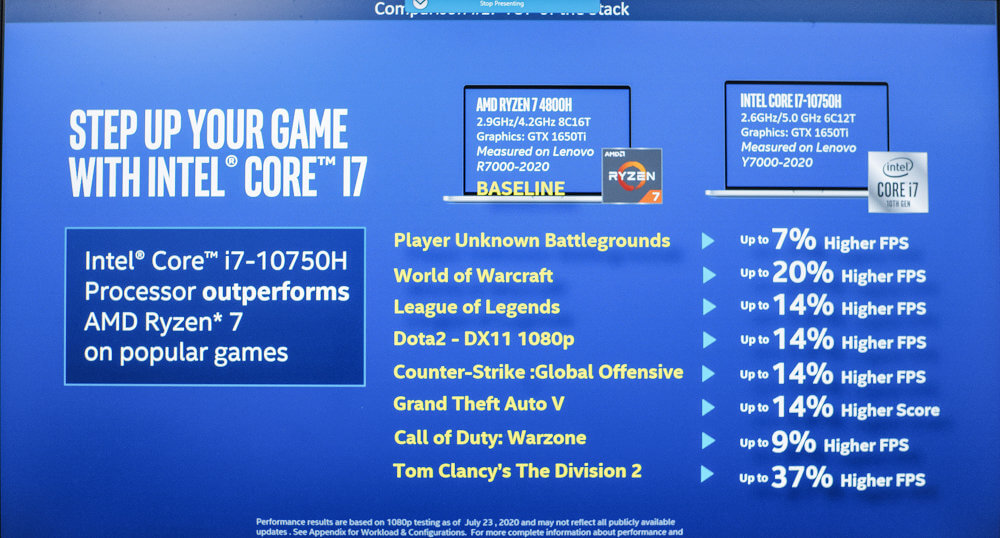Intel has released a new set of Gaming and real-world benchmarks which compares its 10th Gen Comet Lake-H CPU lineup against AMD’s Ryzen 4000 processors codenamed as ‘Renoir’. These are part of Intel’s internal ‘Real World Performance’ testing methodology, which has been criticized heavily in the past. We have already seen examples where Intel used different configurations when testing their own CPUs against the competing chips from AMD, giving their CPU lineup an unfair advantage in the end.
Now, in a latest set of benchmarks as published by Benchlife, coming via Wccftech, Intel is shown comparing its own 10th Gen Core i7-10750H Comet Lake-H mobile CPU against AMD’s Ryzen 7 4800H Renoir APU.
The Intel Core i7-10750H CPU packs 8 cores and 16 threads, and is based on a 14nm process node having 2.60 GHz base and 5.00 GHz boost clocks, and the TDP is configured at 45W. Whereas the AMD Ryzen 7 4800H is an 8 core and 16 threads APU, fabbed on a 7nm process node, and is having 2.9 GHz base and 4.2 GHz boost clock speeds, respectively. One important thing to note here is that the 45 Watts TDP of the core i7 CPU is the PL1 state value derived at 2.60 Ghz clock speed, which is less than the actual PL2 TDP rating of 80 Watts, which is measured at 5.00 Ghz clock speed. So we need to take this info into consideration, because the AMD Ryzen 7 4800H APU maintains its clock frequencies within the 45 Watt TDP envelope.
Coming to the Gaming and real-world benchmarks, Intel has used two similar laptop configurations for both these CPUs this time. The following laptop Models were used, the Lenovo R7000-2020 (AMD) and Lenovo Y7000-2020 (Intel). The full specs are listed below courtesy of ‘Benchlife’.
Lenovo Y7000-2020:
- Intel® Core i7-10750H Processor (2.6 GHz base up to 5.0 GHz, 6C/12T, 45 W TDP) measured on Lenovo Y7000-2020
- 16GB DRAM (2 x 8 GB DDR4 2933MHz)
- 512G SSD
- 1920 x 1080 display
- Nvidia GeForce GTX 1650Ti 4GB
- OS: Microsoft Windows 10 Home V1909 18363.836
- Battery 60WHr
Lenovo R7000-2020:
- AMD Ryzen 7 4800H Processor (2.9 GHz base up to 4.2 GHz, 16T/8C, 35 W TDP) measured on Lenovo R7000-2020
- 16GB DRAM (2 x 8 GB DDR4 3200MHz)
- 512G SSD
- 1920 x 1080 display
- Nvidia GeForce GTX 1650Ti 4GB
- OS: Microsoft Windows 10 Home V1909 18363.836
- Battery 60WHr
Both the laptop models feature an NVIDIA GeForce GTX 1650 Ti discrete GPU, 16 GB of DDR4 Dual-Channel memory, a 512 GB SSD, 1080P HD display and were running on the same Windows 10 Home V1909 18363.836 OS version, with the only exception being the Memory spec which was configured at 3200 MHz for the AMD platform vs 2933 MH on the Intel system. Intel tested a total of 36 games at their default settings.
Out of 14 games which were tested, the Intel Core i7-10750H got 10% higher FPS on average than AMD’s APU. Tom Clancy’s Division 2 saw a 37% gain in performance, which was the highest. Intel also claims that its own CPU showed an overall better gaming performance than AMD’s Ryzen 4000 APU in several popular e-Sports gaming titles, such as PUBG, World of Warcraft, League of Legends, Dota 2, CSGO, GTA V and Call of Duty Warzone. Apart from this, in 21 gaming titles which were tested, the Intel CPU got more than 3% better average performance than the AMD Renoir APU. ‘Rise of The Tomb Raider’ game on the other hand saw a tie in performance between these two CPUs.
Intel also claims a 25% better performance in productivity workloads as well, such as Powerpoint, Excel, Chrome, and other popular synthetic benchmarks. But Intel did not go for any multi-threaded intensive benchmark, in which AMD easily dominates, so their testing methodology remains controversial. Back in June, Intel’s CEO Bob swan stated that the industry should stop focusing on benchmarks, and they should instead focus on the ‘Benefits and Impact’ of the Technology. But despite all this, INTEL is still relying on its own internal benchmarks. Nevertheless, the following PC games were tested:
Games with performance difference of more than 10%:
- Assassin’s Creed Odyssey
- Counter-Strike: Global Offensive
- Dota 2
- F1 2019
- FINAL FANTASY XIV: Shadowbringers
- Grand Theft Auto V
- JX3
- League of Legends
- Team Fortress 2
- Tom Clancy’s Rainbow Six Siege
- Tom Clancy’s The Division 2
- Total War: Warhammer 2-Campaign
- War Thunder Tank Battle
- World of Warcraft
Games having performance difference of more than 3%, but less than 10%:
- ARK: Survival Evolved
- Ashes of the Singularity: Escalation
- Battlefield 1
- Battlefield V
- Borderlands 3
- Call of Duty: Warzone
- Far Cry 5
- Far Cry New Dawn
- FINAL FANTASY XV
- HITMAN 2
- Justice
- Middle-earth: Shadow of War
- Monster Hunter: World
- Moonlight Blade
- Mount & Blade II: Bannerlord
- PLAYER UNKNOWN’S BATTLEGROUNDS (PUBG)
- Red Dead Redemption 2
- Shadow of the Tomb Raider
- Total War: THREE KINGDOMS
- World of Tanks encore
- World War Z Vulkan
Game(s) having almost the same performance, on par:
- Rise of the Tomb Raider
Hello, my name is NICK Richardson. I’m an avid PC and tech fan since the good old days of RIVA TNT2, and 3DFX interactive “Voodoo” gaming cards. I love playing mostly First-person shooters, and I’m a die-hard fan of this FPS genre, since the good ‘old Doom and Wolfenstein days.
MUSIC has always been my passion/roots, but I started gaming “casually” when I was young on Nvidia’s GeForce3 series of cards. I’m by no means an avid or a hardcore gamer though, but I just love stuff related to the PC, Games, and technology in general. I’ve been involved with many indie Metal bands worldwide, and have helped them promote their albums in record labels. I’m a very broad-minded down to earth guy. MUSIC is my inner expression, and soul.
Contact: Email



